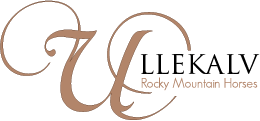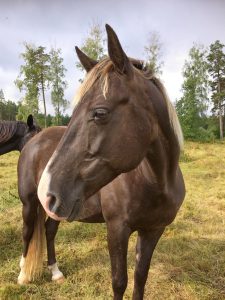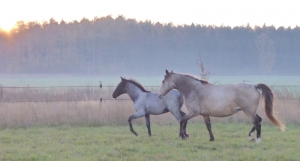 Nu har jag diskuterat inavelsgrad på de avkommor som jag tar fram och för en fölköpare är det självklart det mest intressanta. Men, hur det det ut för mina hästar som jag avlar på, hur ändras det från förälder till avkomma? Varför finns det överhuvudtaget individer med hög inavelsgrad?
Nu har jag diskuterat inavelsgrad på de avkommor som jag tar fram och för en fölköpare är det självklart det mest intressanta. Men, hur det det ut för mina hästar som jag avlar på, hur ändras det från förälder till avkomma? Varför finns det överhuvudtaget individer med hög inavelsgrad?
Dessa siffror finns i RMHAs databas gällande mina hästar:
- Black Pepper: 5,57%
- Lightfoot In The Wind: 5,08%
- FHR Belle’s Wild Flower: 9,74%
- MVR’s Bunny: 7,74%
- Northern Light’s Rose: 6,64%
- Ullekalvs Iris Fortunata: 3,83%
- UIlekalvs Rosalba: 7,35%
- RPM’s Silver Persuasion: 5,06%
- Honey Come Quickly: 4,22%
Rekommendationen är att om inavelsprocenten är över 5% riskerar man att börja se effekter och att man bör hålla sig under 10% för individen och rasen bästa enligt flera källor. Men, det finns individer med högre inavelskoefficienter som levt långa, friska liv och säkert de med lägre inavelsgrad som ändå drabbats av recessiva, genetiska sjukdomar. Ingen av mina hästar ligger över 10% även om det bara är två som är under 5%. På en eller ett par generationer med kloka avelsval kan procenten ändras mycket.
Att man hittar en hel del höga siffror beror till stor del på att Tobe använts så mycket. Även när jag först fick kontakt med rasen skrev man ofta hur hög Tobe-procent man hade, desto högre, desto bättre verkade devisen vara. Att man i vissa fall korsade för att öka Tobe-procenten (och därmed inavelsgraden) märks idag på att många hästar har en högre procent, särskilt om de inte nära
inpå sig har okänd stam. När jag tittat på vad som bidrar till mina avkommors procent är den största delen hela tiden från Tobe och väldigt sällan en häst som inte alls har stam som går tillbaka på Tobe.
När man skapar en ras vill man ta tillvara de egenskaper som man gillar och få så många som möjligt i rasen att ha dessa egenskaper, om det är färger, exteriör, prestation eller en blandning av det är mindre intressant. Lättaste sättet att få individer som nedärver dessa egenskaper är att korsa nära släktingar. Det gjorde man också inom rockyn, exempelvis är Kilburn’s Chocolate
Sundown en avkomma efter att Tobe korsades med sin dotter.
Hästen med högst inavelsgrad som jag hittat är Cheek’s Rocky, född 1967, på 37,5%. Han kom till denna procent genom att hans mor och hans farmor är samma individ och liksom hans farfar, morfar och farmorsfar är samma individ. Det positiva är att han faktiskt inte är en Tobe avkomma, utan representerar en annan linje. Det finns dessutom än idag ett fåtal hästar linjeavlade på denna linje utan Tobe i stammen.
Tittar man på Tobes fem söner så är alla utom Kilburn’s Chocoalte Sundown låga i inavelsprocent. Men, i de flesta fall känner man bara till namnet på deras mor och inget mera vilket gör att de mycket väl kan ha nära släktband till Tobe. Även Tobes stam är till största delen okänd och omdebatterad. Därför skulle inavelsgraden kunna vara högre än vad den kända stamtavlan anger.
- Kilburn’s Chocolate Sundown: 25%
- Johnson’s Toby: 23,44%
- Maples Squirrel: 0%
- Sam Clemon’s Tim: 0%
- Yankee: 6,25%
- Sewell’s Sam: 0%
Ett urval av andra kända hästar som finns i mina hästars stamtavlor. Procenten varierar betydligt. Tex är Sonny (0%) son till Smiths Ginger (18,75%). Så mycket ändras alltså inavelsgraden när man tar ett sto som är helt obesläktat med hingsten.
- Robinsons Sundown Rocky: 19,92%
- Smith’s Ginger: 18,75%
- Barlow Chief: 12,89%
- Buddy Roe: 12,5%
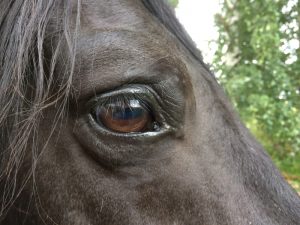
- Broken Bone’s Sam’s Son: 12,5%
- Dan’s Dusty Action: 9,38%
- Nuncio: 9,38%
- Sambo: 7,81%
- Amigo Blue: 6,99%
- Nick: 6,25%
- Woosley’s Rocky: 0%
- Choco: 0%
- Sonny: 0%
- Cana Del Plata: 0%
- Dock: 0%
Mitt mål är i framtiden att komma under en inavelsfrekvens på 5% hos föl födda hos mig. MEN, det kommer inte att bli det enda jag vill uppnå och jag kommer inte att göra mig av med bra hästar som jag redan har bara på grund av inavelskoefficienten. Däremot kommer jag titta ännu mer på det när jag köper nya hästar. Jag har alltid velat ha hästar med så vitt skilda stammar som möjligt, men genom den mätbara inavelskoefficienten kommer det att bli lättare att utvärdera hur väl jag lyckas med det. Att få föl med en inavelskoefficient under 10% kommer inte att bli svårt med dagens hästar, vilket är den gräns man rekommenderar att inte gå över. Hittills har inga föl med högre procent fötts här.
I boken jag läst för att lära mig mer – Managing breeds for a secure future – skriover man även att det nästan går att betrakta som utavel om föräldradjuren inte har någon gemensam släkting närmare än far och morföräldrar. Det gör att avkomman i sin tur inte har några gemensam släktingar tre led bakåt och efter det blir bidraget från en individ väldigt litet. Det stämmer säkert när det handlar om en enstaka individ som dyker upp ett par gånger längre bak i stamtavlan, men Tobe som så ofta återfinns i mina hästars stamtavla har visat sig bidra med förvånansvärt mycket av sitt genetiska material, trots att han i de flesta fall är fyra, fem eller flera generationer tillbaka. Att använda den definitionen, men räkna med Tobes dominans kommer däremot troligen att göra det möjligt att hitta flera olika linjer som man kan hålla separata och använda för utavel.
More about inbreeding
I have been discussing the inbreeding coefficient of the offspring I breed and for the buyers of the foals is that of course the most important. But, what does it look like for the horses I own and how does it change from parent to offspring? Why is there individuals with such high coefficients? This is the COI that RMHAs pedigree database gives for my horses:
- Black Pepper: 5,57%
- Lightfoot In The Wind: 5,08%
- FHR Belle’s Wild Flower: 9,74%
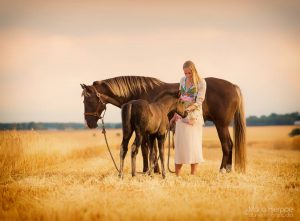
- MVR’s Bunny: 7,74%
- Northern Light’s Rose: 6,64%
- Ullekalvs Iris Fortunata: 3,83%
- UIlekalvs Rosalba: 7,35%
- RPM’s Silver Persuasion: 5,06%
- Honey Come Quickly: 4,22%
The recommendation is that over 5% can inbreeding effects occur and it is best to keep below 10% for the health and benefit of animals and the breed according to several sources. But, there are individuals that have lived long and healthy lives with a much higher COI and those that suffers from genetic, recessive diseases even with a very low COI. Neither of my horses goes above
10% and I am happy about that, even if only two are under 5%. In one or two generations can much change with wise breeding decisions.
That many horses have a high COI is mainly because Tobe has been used so much. When I first got in contact with the breed did many people promote their horses by saying that they had a high “Tobe percentage”. The more the better seemed to be the rule. That probably made people cross their horse to raise the Tobe Percentage (and thereby the COI) and probably a result is that many horses today have fairly high percentages, especially if they don’t have unknown pedigree close up. When I have looked closer at what have contributed to my horses inbreeding percentages is it mainly Tobe, and very rarely a horse that isn’t related to Tobe.
When you want to create a new breed is it important to consolidate the traits you like, it may be conformation, color, performance or other things, that is not that important here. The easiest way to obtain this is often to breed close relatives to each other. That was done with the rocky – Kilburn’s Chocolate Sundown is for example a result from when Tobe covered his own daughter.
The horse with the highest COI that I have found in my horses pedigrees is Cheek’s Rocky, born 1967, with 37,5%. He reached this percentage by his mom and sires dame being the same horse as well as his maternal and paternal grand sire and his paternal maternal sire is the same horse. The positive thing about that it is another strain and not an offspring to Tobe and that there still is a few young, breding individuals of that strain that hasn’t Tobe in the pedigree.
All of Tobe’s sons have a low COI, except Kilburn’s Chocolate Sundown. But, in most cases is only the name of their dame known, not anything about her lineages. Not much is known about Tobe’s pedigree either. That means that they can have a higher COI as they could possibly be related to Tobe.
Tobes five sons:
- Kilburn’s Chocolate Sundown: 25%
- Johnson’s Toby: 23,44%
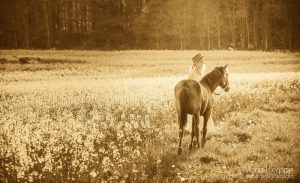
- Maples Squirrel: 0%
- Sam Clemon’s Tim: 0%
- Yankee: 6,25%
- Sewell’s Sam: 0%
Some of the well-known horses that exist in my horses pedigrees. The COI varies a lot. For example is Sonny (0%) a son of Smith’s Ginger (18,75%). That is how it can change if you breed a high COI to a non-related horse.
- Robinson’s Sundown Rocky: 19,92%
- Smith’s Ginger: 18,75%
- Barlow Chief: 12,89%
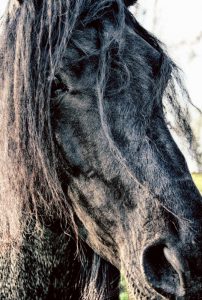
- Buddy Roe: 12,5%
- Broken Bone’s Sam’s Son: 12,5%
- Dan’s Dusty Action: 9,38%
- Nuncio: 9,38%
- Sambo: 7,81%
- Amigo Blue: 6,99%
- Nick: 6,25%
- Woosley’s Rocky: 0%
- Choco: 0%
- Sonny: 0%
- Cana Del Plata: 0%
- Dock: 0%
My goal in the future is to get below 5% for the foals born at my place. BUT, it isn’t going to be the only thing I look at and I’m not going to get rid of good horses that I already have just because of the COI. I am going to look even more carefully at COI when buying new horses. I have always tried to get horses far apart in lineages , but COI is going to make that easier, both COI of the animal, but also COI of offspring from the crosses that I can get. To get foals with an COI under 10% isn’t difficult for me, so far hasn’t any foal born here been over that.
In the book I have been reading “Managing breeds for a secure future” is it also stated that if the breeding can nearly be regarded as outbreeding if there is no common ancestors until after grand parents as relatives further back than great-grandparents isn’t going to submit much genetic material to the offspring. That is probably true when it only occures once in the pedigree, but as with Tobe in the Rocky Mountain his genetic material still adds upp, even when further back in the pedigree. But using that definition is probably going to make it easier to find more linages that can be kept separate and that can be used for outbreedings.
